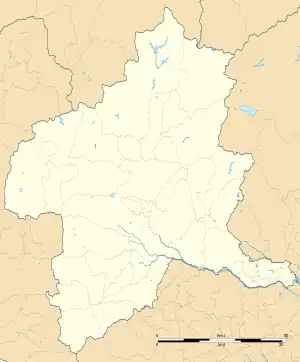Ino Station 井野駅 | ||||||||||||||||||||||||||||
|---|---|---|---|---|---|---|---|---|---|---|---|---|---|---|---|---|---|---|---|---|---|---|---|---|---|---|---|---|
 Ino Station building, December 2006 | ||||||||||||||||||||||||||||
| General information | ||||||||||||||||||||||||||||
| Location | Inomachi, Takasaki-shi, Gunma-ken 370-0004 Japan | |||||||||||||||||||||||||||
| Coordinates | 36°21′26″N 139°01′23″E / 36.35722°N 139.02306°E | |||||||||||||||||||||||||||
| Operated by | ||||||||||||||||||||||||||||
| Line(s) | ||||||||||||||||||||||||||||
| Distance | 4.0 km (2.5 mi) from Takasaki | |||||||||||||||||||||||||||
| Platforms | 2 side platforms | |||||||||||||||||||||||||||
| Other information | ||||||||||||||||||||||||||||
| Status | Staffed | |||||||||||||||||||||||||||
| Website | Official website | |||||||||||||||||||||||||||
| History | ||||||||||||||||||||||||||||
| Opened | 20 December 1957 | |||||||||||||||||||||||||||
| Passengers | ||||||||||||||||||||||||||||
| FY2022 | 1,946 daily | |||||||||||||||||||||||||||
| Services | ||||||||||||||||||||||||||||
| ||||||||||||||||||||||||||||
| Location | ||||||||||||||||||||||||||||
 Ino Station Location within Gunma Prefecture  Ino Station Ino Station (Japan) | ||||||||||||||||||||||||||||
Ino Station (井野駅, Ino-eki) is a railway station in the city of Takasaki, Gunma, Japan, operated by the East Japan Railway Company (JR East).[1]
Lines
Ino Station is served by the Joetsu Line, and is 4.0 km (2.5 mi) from the starting point of the line at Takasaki, and 161.6 km (100.4 mi) from Nagaoka Station. The preceding station of Takasakitonyamachi is 1.2 km (0.75 mi) away and the following station of Shin-Maebashi is 3.3 km (2.1 mi) away. It is also served by through services to and from the Agatsuma Line and the Ryōmō Line.
Station layout
The station consists of two opposed side platforms serving two tracks, connected to the station building by a footbridge. Ino Station has a Braille fare table, and no other accessibility features.[1]
Platforms[2]
| 1 | ■ Jōetsu Line | for Shibukawa, Minakami, and Nagaoka |
| ■ Agatsuma Line | for Nakanojō and Naganohara-Kusatsuguchi | |
| ■ Ryōmō Line | for Maebashi, Kiryū and Oyama | |
| 2 | ■ Jōetsu Line | for Takasaki |
| JS Shōnan-Shinjuku Line | for Takasaki, Shinjuku and Yokohama | |
| JU Takasaki Line via (Ueno-Tokyo Line) | for Takasaki, Tokyo and Yokohama |
 Ticket Gate July 2021
Ticket Gate July 2021 Platform July 2021
Platform July 2021
History
The site of the station was first used as a signal station from 11 October 1944 until 20 December 1957 when the station was opened.[3] Upon the privatization of the Japanese National Railways (JNR) on 1 April 1987, it came under the control of JR East.
The station started accepting Suica cards on 18 November 2001. The Midori no Madoguchi ticket office was closed on 30 November 2021.[4]
Passenger statistics
In fiscal 2022, the station was used by an average of 1,946 passengers daily (boarding passengers only).[5]
Below is table containing the passenger statistics since the year 2000:
| Passenger statistics | |||||
|---|---|---|---|---|---|
| Year | Average Daily
Boarding Passengers |
Year | Average Daily
Boarding Passengers |
Year | Average Daily
Boarding Passengers |
| 2000 | 3,134[6] | 2010 | 2,042[7] | 2020 | 1,649[8] |
| 2001 | 2,955[9] | 2011 | 2,036[10] | 2021 | 1,809[11] |
| 2002 | 2,888[12] | 2012 | 2,024[13] | 2022 | 1,946[5] |
| 2003 | 2,789[14] | 2013 | 2,118[15] | ||
| 2004 | 2,809[16] | 2014 | 2,059[17] | ||
| 2005 | 2,529[18] | 2015 | 2,090[19] | ||
| 2006 | 2,422[20] | 2016 | 2,102[21] | ||
| 2007 | 2,265[22] | 2017 | 2,129[23] | ||
| 2008 | 2,230[24] | 2018 | 2,181[25] | ||
| 2009 | 2,123[26] | 2019 | 2,155[27] | ||
Surrounding area
 National Route 17
National Route 17- Takasaki Ino Post Office
See also
References
- 1 2 各駅情報(井野駅) [Station Information: Ino Station] (in Japanese). Japan: East Japan Railway Company. Retrieved 7 September 2012.
- ↑ "JR東日本:駅構内図(井野駅)". JR東日本:東日本旅客鉄道株式会社 (in Japanese). Retrieved 8 April 2023.
- ↑ Soda, Keisuke. "上越線の線路をたどる" [Following the tracks of the Joetsu Line]. Railway Pictorial (in Japanese). 電気車研究会 (934): 49–67.
- ↑ "『井野駅「みどりの窓口」は、2021-11-30をもって営業を終了します』". さんちゃんの駅ブログ (in Japanese). Retrieved 8 April 2023.
- 1 2 "各駅の乗車人員 2022年度 ベスト100以下(4)|企業サイト:JR東日本". JR東日本:東日本旅客鉄道株式会社 (in Japanese). Retrieved 7 July 2023.
- ↑ "JR東日本:各駅の乗車人員(2000年度)". www.jreast.co.jp. Retrieved 8 April 2023.
- ↑ "JR東日本:各駅の乗車人員(2010年度)". www.jreast.co.jp. Retrieved 8 April 2023.
- ↑ "各駅の乗車人員 2020年度 ベスト100以下(4)|企業サイト:JR東日本". JR東日本:東日本旅客鉄道株式会社 (in Japanese). Retrieved 8 April 2023.
- ↑ "JR東日本:各駅の乗車人員(2001年度)". www.jreast.co.jp. Retrieved 8 April 2023.
- ↑ "JR東日本:各駅の乗車人員(2011年度)". www.jreast.co.jp. Retrieved 8 April 2023.
- ↑ "各駅の乗車人員 2021年度 ベスト100以下(4)|企業サイト:JR東日本". JR東日本:東日本旅客鉄道株式会社 (in Japanese). Retrieved 8 April 2023.
- ↑ "JR東日本:各駅の乗車人員(2002年度)". www.jreast.co.jp. Retrieved 8 April 2023.
- ↑ "JR東日本:各駅の乗車人員(2012年度)". www.jreast.co.jp. Retrieved 8 April 2023.
- ↑ "JR東日本:各駅の乗車人員(2003年度)". www.jreast.co.jp. Retrieved 8 April 2023.
- ↑ "各駅の乗車人員 2013年度 ベスト100以外(5):JR東日本". www.jreast.co.jp. Retrieved 8 April 2023.
- ↑ "JR東日本:各駅の乗車人員(2004年度)". www.jreast.co.jp. Retrieved 8 April 2023.
- ↑ "各駅の乗車人員 2014年度 ベスト100以外(5):JR東日本". www.jreast.co.jp. Retrieved 8 April 2023.
- ↑ "JR東日本:各駅の乗車人員(2005年度)". www.jreast.co.jp. Retrieved 8 April 2023.
- ↑ "各駅の乗車人員 2015年度 ベスト100以外(4):JR東日本". www.jreast.co.jp. Retrieved 8 April 2023.
- ↑ "JR東日本:各駅の乗車人員(2006年度)". www.jreast.co.jp. Retrieved 8 April 2023.
- ↑ "各駅の乗車人員 2016年度 ベスト100以外(4):JR東日本". www.jreast.co.jp. Retrieved 8 April 2023.
- ↑ "JR東日本:各駅の乗車人員(2007年度)". www.jreast.co.jp. Retrieved 8 April 2023.
- ↑ "各駅の乗車人員 2017年度 ベスト100以外(4):JR東日本". www.jreast.co.jp. Retrieved 8 April 2023.
- ↑ "JR東日本:各駅の乗車人員(2008年度)". www.jreast.co.jp. Retrieved 8 April 2023.
- ↑ "各駅の乗車人員 2018年度 ベスト100以外(4):JR東日本". www.jreast.co.jp. Retrieved 8 April 2023.
- ↑ "JR東日本:各駅の乗車人員(2009年度)". www.jreast.co.jp. Retrieved 8 April 2023.
- ↑ "各駅の乗車人員 2019年度 ベスト100以外(4):JR東日本". www.jreast.co.jp. Retrieved 8 April 2023.
External links
![]() Media related to Ino Station (Gunma) at Wikimedia Commons
Media related to Ino Station (Gunma) at Wikimedia Commons
- Ino Station information (JR East) (in Japanese)